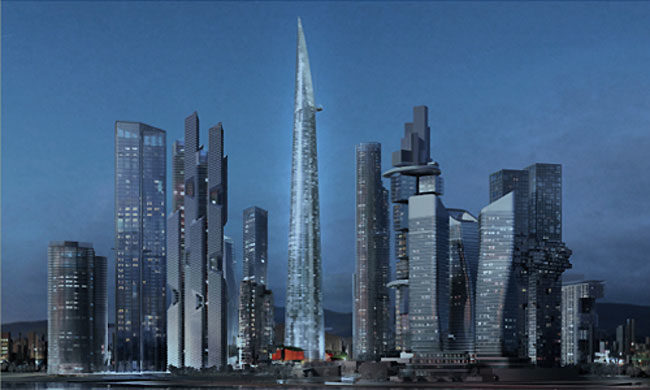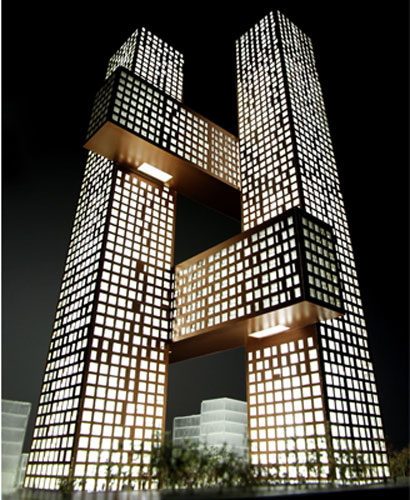| Image courtesy Dreamhub |
|
The 620-m-tall Landmark Tower, designed by Renzo Piano Building Workshop, will dominate Seoul's 3.4-million-sq-m multibuilding Yongsan International Business District. |
Unusual double-helix external bracing will stabilize a 620-meter-tall tower at the center of the 20-building Yongsan International Business District, planned for a 3,000-hectare site next to the Han River in Seoul, South Korea. The conical skyscraper is among the first of the major buildings scheduled to start construction soon, now that conceptual designs for the 3.4-million-square-meter brownfield development have been completed.
Teams of local and international architects and engineers announced their concepts for each of Yongsan's planned buildings earlier this month, marking the start of the project's design development phase. International designers will continue to lead work on the conical structure, called the Landmark Tower, and two other buildings. However, local firms will drive the rest of the work, with the international collaborators providing advice where needed. The first buildings could be ready for use in about four years, according to the current schedule.
The development consortium, Dreamhub Project Financial Investment Co. Ltd., has yet to sign design contracts, but preliminary work on the site has started, says Alistair Guthrie, a director of Arup Group Ltd., London. Arup supported master-planning work on Yongsan by the New York City office of Studio Daniel Libeskind and went on to handle engineering design on eight of the buildings. They include the soaring Landmark tower, conceived by architect Renzo Piano Building Workshop, and the residential twin towers, which are linked by bridging buildings, by Bjarke Ingels Group (BIG), Copenhagen.
Arup's lead structural director on the Landmark Tower, Bob Lang, believes the DNA-like external bracing has never been used on such a scale. Rising from a 76-m-dia footprint, the building will taper to an obliquely sliced peak about 22 m wide. From its concrete core, floor slabs will span to 16 large inclined composite columns around the perimeter. To brace the tower against wind and seismic forces, two pairs of twin tubes, up to 80 centimeters in diameter, will spiral in opposite directions around the perimeter, crossing at nodes at every third level. Locally based Samsung C&T Corp. has worked on the project's design and is the designated main contractor.
Though smaller in size, BIG's design for the bridge-linked residential towers have been no less challenging. Like most of Yongsan's buildings, the towers are planned to be visually striking, says BIG's project leader, Andre Schmidt. "In a city where many people live in monotonous company apartments, Dreamhub is interested in getting something new,” he adds. BIG's design incorporates 214-m-tall and 204-m-tall concrete-framed towers with roughly 40-sq-m footprints. They will be linked by seven-story connecting buildings that cross from one tower to the other. One starts 70 m above ground and the other at 140 m above ground. The steel-framed bridge buildings will be more than 100 m long and 20 m wide.
The steel frames of the bridge buildings, which Arup's project director, Rory McGowan, calls “torsional boxes,” will be embedded into extended core walls of the towers. The supporting vertical embedded steel members will continue down through the walls to the foundations. Under normal conditions, the towers will be drawn together in different directions by the bridge buildings. However, the towers will have “some degree of independence” in seismic conditions, says McGowan. From a structural viewpoint, “the thing that most taxed us was understanding the behavior of the two towers under wind and seismic events,” he adds. Seoul has low to moderate seismicity. “Wind governs our design,” says Arup’s Lang.












